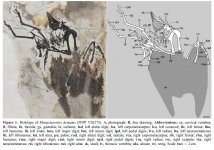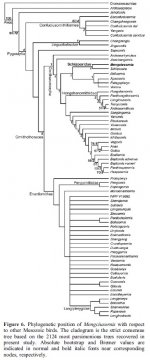Fred Ruhe
Well-known member

Min Wang, Jingmai K. O’Connor, Shuang Zhou & Zhonghe Zhou, 2019
New toothed Early Cretaceous ornithuromorph bird reveals intraclade diversity in pattern of tooth loss
Journal of Systematic Palaeontology. Online edition. doi:10.1080/14772019.2019.1682696
Abstract and free pdf: https://www.tandfonline.com/doi/abs/10.1080/14772019.2019.1682696?journalCode=tjsp20
The earliest record of the Ornithuromorpha, which includes crown birds, is currently known from the Early Cretaceous Jehol Biota in north-eastern China. Here we describe a new ornithuromorph bird, Mengciusornis dentatus gen. et sp. nov., from the Jiufotang Formation of this biota. Mengciusornis preserves a suite of morphological features exclusively observed among ornithuromorphs in the sympatric taxon Schizooura, including a robust and ‘V’-shaped furcula with a short hypocleidium, and a humerus with a large, rectangular deltopectoral crest in which the distodorsal corner is distinctively developed into a sharp, angular point. The results of our phylogenetic analysis recover these two species together in a clade, positioned stemward within the Ornithuromorpha. Mengciusornis has toothed premaxillae, in stark contrast with the edentulous jaws of Schizooura, demonstrating that dentition varied considerably between some closely related species. Furthermore, all previously known Jehol ornithuromorphs with toothed premaxillae have an edentulous rostral portion of the element, suggesting that tooth loss in this clade proceeded from the rostral end caudally, whereas in Mengciusornis the premaxilla lacks this edentulous rostral tip although the maxilla and dentary are toothless, indicating that the pattern of tooth loss, not unexpectedly, varied between lineages of ornithuromorphs. This observation suggests a strong degree of plasticity in the developmental mechanisms regulating tooth and beak formation, which is supported by earlier evidence that indicates teeth have been lost multiple times within Aves and Dinosauria. Mengciusornis preserves a ventrally hooked scapular acromion that is convergently evolved in parallel with some enantiornithines and neornithines, providing further evidence of the homoplasy that characterizes avian evolution.
http://zoobank.org/urn:lsid:zoobank.org:pub:311B34B9-1CBF-47A6-B821-650C04560137
Enjoy,
Fred
New toothed Early Cretaceous ornithuromorph bird reveals intraclade diversity in pattern of tooth loss
Journal of Systematic Palaeontology. Online edition. doi:10.1080/14772019.2019.1682696
Abstract and free pdf: https://www.tandfonline.com/doi/abs/10.1080/14772019.2019.1682696?journalCode=tjsp20
The earliest record of the Ornithuromorpha, which includes crown birds, is currently known from the Early Cretaceous Jehol Biota in north-eastern China. Here we describe a new ornithuromorph bird, Mengciusornis dentatus gen. et sp. nov., from the Jiufotang Formation of this biota. Mengciusornis preserves a suite of morphological features exclusively observed among ornithuromorphs in the sympatric taxon Schizooura, including a robust and ‘V’-shaped furcula with a short hypocleidium, and a humerus with a large, rectangular deltopectoral crest in which the distodorsal corner is distinctively developed into a sharp, angular point. The results of our phylogenetic analysis recover these two species together in a clade, positioned stemward within the Ornithuromorpha. Mengciusornis has toothed premaxillae, in stark contrast with the edentulous jaws of Schizooura, demonstrating that dentition varied considerably between some closely related species. Furthermore, all previously known Jehol ornithuromorphs with toothed premaxillae have an edentulous rostral portion of the element, suggesting that tooth loss in this clade proceeded from the rostral end caudally, whereas in Mengciusornis the premaxilla lacks this edentulous rostral tip although the maxilla and dentary are toothless, indicating that the pattern of tooth loss, not unexpectedly, varied between lineages of ornithuromorphs. This observation suggests a strong degree of plasticity in the developmental mechanisms regulating tooth and beak formation, which is supported by earlier evidence that indicates teeth have been lost multiple times within Aves and Dinosauria. Mengciusornis preserves a ventrally hooked scapular acromion that is convergently evolved in parallel with some enantiornithines and neornithines, providing further evidence of the homoplasy that characterizes avian evolution.
http://zoobank.org/urn:lsid:zoobank.org:pub:311B34B9-1CBF-47A6-B821-650C04560137
Enjoy,
Fred
Last edited:





